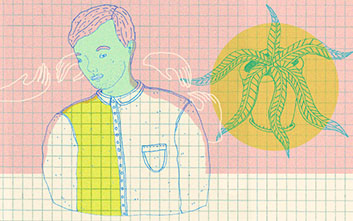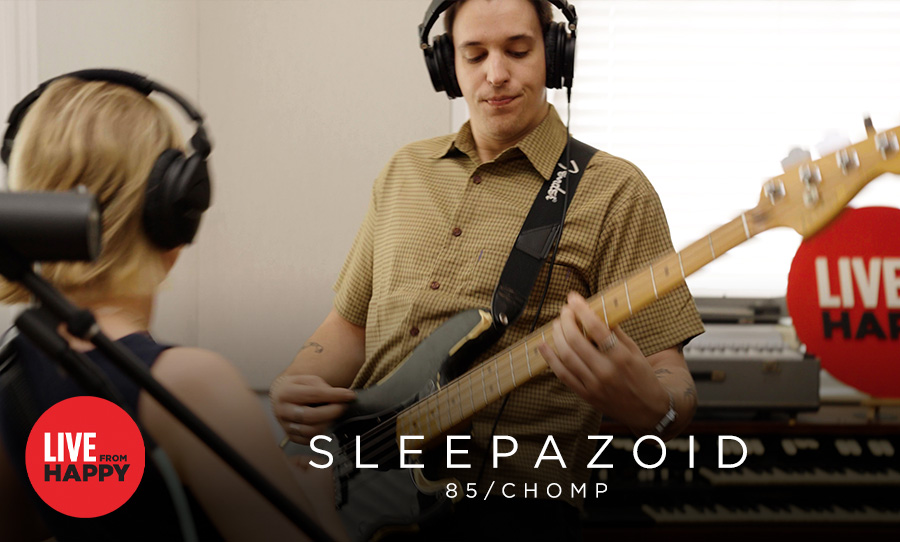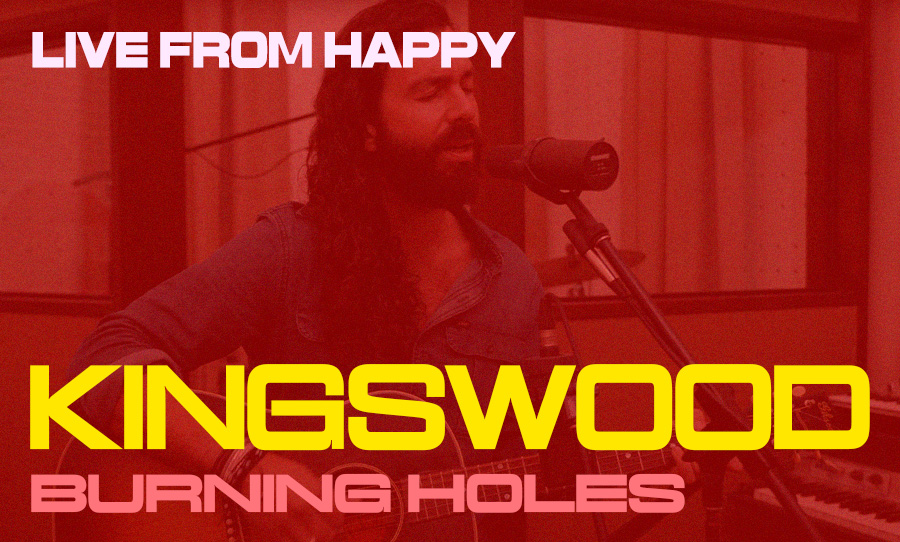Following the release of Life of Pause, we got the chance to get have a heart to heart with Wild Nothing. The man behind the moniker, Jack Tatum, discusses his new album and what he calls his best songwriting so far.

This sweet illustration of Wild Nothing comes from the talented Marney Anderson. Head to her site for more of her awesome work.
HAPPY: How has the reception to the record been so far?
JACK: It seems good so far, I think I’ll be a lot more curious once people have heard the whole album.
HAPPY: What was the premise behind releasing two singles within one video (To Know You and Tv Queen) – are the two tracks meant to be listened to in succession or is it some sort of metaphor for a kind of duality within the record?
JACK: Honestly it didn’t really go that deep. They both share a different version of the record in some sense but I wouldn’t say they represent a duality – they aren’t that connected in my mind. I think of all the songs on the record there is something about TV Queen that feels the most familiar, like it’s got one feet in the new material and another in the old material. I liked that it could serve as a bridge in that way, with To Know You being something slightly different and more pointed. I think if anything that was the idea, for the first music people to hear to have something new and familiar at the same time.
HAPPY: You’ve said in the past that you feel a constant need to progress and re-invent. How did you achieve this with Life of Pause? What kind of identity do you think the final product took on?
JACK: If I’m being honest with myself, this record isn’t necessarily a re-invention. There’s obviously a lot of parallels between this record and the previous material, but there was a definite effort made to try and stretch those lines out as much as I could. I feel like you’re always slightly tied to your previous material, and to me that’s not a bad thing. The goal should always be to try and do something new and say something new, but you’ve always got that old stuff tagging along behind you. Sometimes as a songwriter I have this desire to cut ties with my past but it always comes back around. It’s a constant identity mutation. This record is much more well-rounded in my opinion, it’s more varied. It’s more like my current self, a bit less self-conscious, a bit less concerned with genre alignment. The older I get the less care about what “kind” of songs I’m writing, I just want to write songs.
HAPPY: Can you tell me a little about the writing / experimentation period for the record? Where were you, what gear were you using, what inspired you, what is your writing process like as a solo songwriter?
JACK: Well I wrote pretty much all of the record in NY at my apartment. At the time I had a little set-up where I could demo things out. Space is an obvious issue in the city so I was constantly battling my own limitations. When I lived in Virginia and Georgia it was great because I could spread myself out and do whatever I wanted, but in NY I had to be a bit more choosy about what I could do. So really the bulk of the record came together in my tiny office with one guitar, bass and a couple synthesizers. We ended up taking all my demos and then re-tracking everything in Stockholm and Los Angeles. We really tried to do everything as “traditionally” as we could. It’s a total cliche these days to be all “yeaaah man gotta do it analog”. It’s annoying, I get it. But I think there was this underlying sense that everything had to be very organic. I’ve always referenced music from other eras and that’s part of it. It sort of felt like a personal challenge to ourselves, that we would try and get as many full takes of each instrument.
Even though there are a lot of electronic elements on the record they’re all actually played by people and not programmed. We used all vintage synthesizers in Stockholm and Los Angeles, ARP, Korg, Roland, Moog. We just tried to stay outside of the computer as much as possible, it’s impossible to avoid obviously, but when we could we would. We also layered a lot. Part of trying to create an identity for this record was that I wanted to try get sounds that wouldn’t be so straight forward. The guitars and synths are often doubled, sometimes we’d double things with saxophone. The lead line in “Lady Blue” for instance is sax and several different keyboards layered all together. I think theres a lot of moments on the record too where we have “organic” instruments that are treated in a way that makes them sound unnatural. There’s a lot of stuff on the record that people might mistake for synth but aren’t.
HAPPY: Do you feel like this is some of the best song-writing you’ve done?
JACK: I do. I think it’s the most diverse at least. Everyone’s got something that they look for in music though. My thing isn’t going to be everyone’s thing, but I think this is my best record.
HAPPY: While there is an element of darkness to the record, as with all of your music, Life of Pause feels a little more optimistic than your previous work. What was your emotional head space when writing the record?
JACK: I’ve been in a much more stable headspace the past few years and I think this record reflects that. I’m a happy person, I don’t feel the need to inject my life with drama for the sake of inspiration. I’m perfectly content with living my normal life and being inspired by the music I love. I think there’s always going to be an element of doubt in my music because I’m a curious person and I have questions about my life, but it also feels really good that I can make a record like this at this moment in my life. I’m getting older, things have evened out for me in a lot of ways and I think they’ll continue to do that. I don’t know exactly how that will effect my music in the future.
HAPPY: You have quite a defined visual style (album art, press shots, videos etc) – it’s clean and delicate but also very mysterious and almost brooding. Where does this come from? Is this a product of yourself or do you collaborate with anyone?
JACK: Sometimes I’m not really aware of what the visual identity of a record is going to be until it’s entirely complete, like I just need to wait until I can step back and inspect it all before it hits me. The main thing with this record was that I felt like there was a tangible sense of space. It really started that broad. From there it turned into the idea of actually creating a physical space, a sort of room in this world, and I knew that I wanted to include myself in the world because this felt like the first opportunity that made sense to do that. I worked with a photographer named Shawn Brackbill who helped me conceptualize the album art. We spent a lot of time going back and forth sharing inspiration. I was really drawn to a Japanese artist named Shuji Terayama who took a lot of interesting portrait photographs.
Over the next month we went back and forth on a lot of different things, lots of classic album covers, Bob Dylan’s “Bring It All Back Home”, Fripp and Eno, lots of Hipgnosis designs, stills from Wim Wender’s movies and some sci-fi stuff like Bladerunner. Our album art didn’t end up emulating any of this things exactly but this was the kind of stuff we were considering. I worry about the art a lot. I never know if it’s going to be successful or not but once there is an idea there I feel the need to see it through. The goal was to try and create something that isn’t of any one “moment”. I’d hate for the art to be overly retro but I also don’t want it to feel particularly current either. Timeless I guess, which is easier said than done but worth striving for.
HAPPY: Is there any particular gear / equipment in the studio that really helped shape the record?
JACK: Yeah so much, I could go for ages. The studio we started recording at in Stockholm had a beautiful 70’s API console. There were a million keyboards in Stockholm and Los angeles that we used extensively too. The Arp Odyssey ended up all over this record, as well as an Arp Solina. The Moog Minimoog and Rogue ended up on the record, a few other string synths like the Korg Delta and Roland RS-09. I used a Stratocaster on basically every song, and we tracked a lot of the guitar parts through a Roland RE-501 chorus echo. There was another tape echo that my producer Thom Monahan had that is a weird Japanese space echo knock off. We got a lot of great, scrappy overdrive tones out of it by taking the echo down and cranking the gain. Thom has a small room in his studio with a million tiny tube amps.
A lot of times we’d be going through two amps at once. All the bass on the record is either P-bass or Rickenbacker. For the real dorks, the record was mixed on a small SSL desk. Jake Portrait who mixed the record works entirely in outboard. He’s got it routed so strangely that I couldn’t give away any secrets even if I tried though. I wouldn’t say there were any particularly “magic” compressors or pieces of gear on this record though anyway. Although he had just gotten an AMS RMX-16 reverb unit which was pretty exciting and ended up on a lot of the record.
HAPPY: There is a definite natural sort of spaciousness on Life of Pause that wasn’t quite there on Nocturne or Gemini. Things feel like they are moving constantly. Were there any particular things you tried to achieve sonically on the record?
JACK: I mean, what you just mentioned is pretty much what I hoped to accomplish, so that makes me really happy. I wanted this record to feel more alive, to be a little looser and open. I’ve always been a perfectionist and despite all my best efforts I can’t say that’s changed on this record, but I did have a desire to unclench my fists a bit, you know? And in some ways I did. Like for instance, all the drums on Nocturne were quantized meaning we went in and manually locked everything to a grid. It’s so time-consuming and mind-numbing and just insane. But we did that because it’s what I wanted. I wanted everything to feel very strict and almost programmed sounding. I wanted to give that kind of thinking up with this record.
HAPPY: Do you literally record each and every part on the record? Is it an extremely exhausting process? Can you tell us a little more of how you work in-studio?
JACK: I didn’t sing all the backing vocals or play drums, marimba, and saxophone on this record, but otherwise yeah it’s all me. It’s pretty exhausting in the moment. I mean we tracked for a solid 6 weeks, in the studio for 10 hours a day. But it’s so fun, I wouldn’t trade it for anything. When you make records like this it’s important to have a good relationship with your producer, which I did with Thom. We just tackled it one thing at a time, one song at a time. It takes a lot of patience and trial and error. I’d have days where I’d completely freak out because I was afraid that it wasn’t going well and other days when I’d be so ecstatic. It can be a lot of pressure to put on yourself when you do so much of the work on a record but I think it’s worth it.



